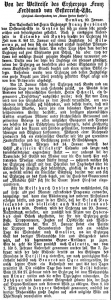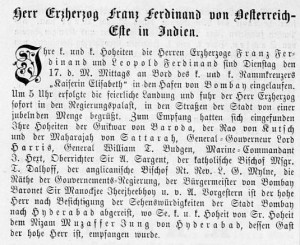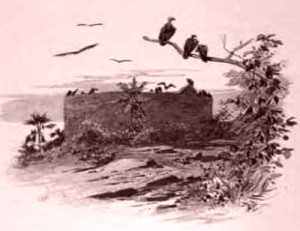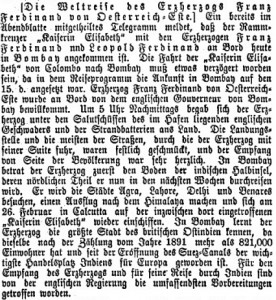Whoever arrives directly from the majestic cold of the Alpine world to Benares will believe to be in a madhouse. Gods and humans, religion and madness; mysticism and superstition; asceticism and luxury, echoes of deep truths and denial of common sense, godly praying men and crazy fakirs, burning Hindus and dancing bayaderes: all of this is grouped at the river in a hundred varieties and forms, bottles up the streets of the city, rushing, squeezing, pushing, driving — united in a maelstrom and vortex which threatens to envelop the starring stranger made speechless out of astonishment. Only slowly is it possible to collect, observe and think in the midst of this huge human aberration and the infectious manic force.
Benares, the holy city of the Hindus, is the largest place of an annual pilgrimage in India visited by a few hundred thousand pilgrims. It lies on the left, northern bank of the holy Ganges river an covers a large area — containing 222.000 souls — which is filled mostly by temples, mosques and palaces of Indian princes. There are, besides other religious buildings, 1454 Hindu temples and 572 mosques. The city, an ancient site of Brahmin erudition, was originally only dedicated to Buddhist believers until that was displaced by Brahmanism. In the middle of the 17th century incorporated into the Mughal empire its place as a holy city of the Hindus was temporarily lost, namely by Aurangzeb, as eager a believer in Islam as a persecutor of Brahmanism, who had all temples destroyed, scorning the Hindus, and erected partly on the ruins of these temples a large number of mosques along the shores of the Ganges. After the fall of the Mughal reign, having regained their strength, the Hindus built nearly one thousand five hundred new temples displacing the mosques. Even if their number and style might astonish us, we still notice a certain uniformity of style, a feature explained by the fact that all Hindu temples currently standing in Benares date back no longer than the 17th century.
The sun had hardly pieced the morning mist hanging over the holy Ganges when we were already at the shore of the river. Here we rented a short rowing boat and had us rowed up and down the river in order to gain an overview of the palaces and temples and life at the shore. Above the shoreline are a number of palaces that Indian princes such as the Maharajas of Nepal, Jeypore etc. had constructed as local residences for the large number of annual pilgrims from their state. Galleries with ornamented fronts flanked at both ends with massive corner towers are common. Between these palaces stand here and there many Hindu temples, some well maintained some in ruins many of which have been undermined by the active river while others incline so strongly that the difference to the vertical is way beyond that of the leaning tower of Pisa.
Everywhere large open stone stairs (Ghats) lead down to the water in front of the continuing rows of buildings. On these stairs there is a lot of activity going on in the morning which at first seems surprising to a spectator and defies description. Here the pilgrims and the majority of the population of Benares congregate to bathe in the holy river and thus receive absolution for all their sins. Here, the religious life, thinking, feeling and striving of the Hindus are pulsating. Here the scrupulous observation of religious obligations is transformed into crass fanaticism, indolence into enthusiasm. Laymen and priests, men and women of all ages, boys, girls and children push in masses to the get into the water. There a poor old man with snow white hairs, freezing from the cold, submerges himself in the water. Here a group of Brahmin take an expurgating bath. A grandmother old as the hills led by her nephew approaches the river. There a group of bathing girls whose joy is not suffocated by belief. Fidgety crying children are doused with water or dunked into the muddy broth by their parents. Everywhere, however, modesty is preserved and even in the water the light linen cloth are never removed.
The morning was very cool — we were sitting in overcoats in our boat — but the severe cold id not in the least impede the faithful in taking their bath or to remain in the water for extended time. The bathers drank from the disgusting water which has the power to absolve the mortal human of his sins thanks to Shiva’s grace. They sacrifice flowers and rice and other agricultural products. The Brahmins are performing their holy rituals especially festively and glance at the sun, murmur their prayers and offer their sacrifices in strange ceremonies. Pilgrims take the holy water of the Ganges home in large copper containers. The water is also sent out in all parts of the country. In all of Benares one can see carriers of this holy liquidity in the streets.
Just above the bathing places on the Ghat are pillars on stone slabs on which Brahmins are sitting who paint caste signs with diversely colored sandalwood paste on the front and cheeks of the returning bathers. Barbers too had set up their business and were hard at work.
The most terrible spawn of religious paroxism, true caricatures of mankind, however, are the fakirs who are legion in Benares. They sit motionless on the Ghats or on planks swimming in the river, mostly naked, smeared in mud or ashes. Their livelihood is provided by the charity of the believers.
Amidst all the bathing places are the burning locations where numerous Hindu bodies are daily transformed. It is said to be especially godly to be turned into ashes or even die at the shores of the Ganges and serves as a pledge of entry into heaven. For this reason many dying have themselves carried from far away places to the holy river by their relatives to exhale their last breath in view of the flowing river. If death doesn’t strike quickly, the caring relatives will probably assist the process to be able to return home soon. The bodies are handled without piety according to the custom of the land. They are first shaved and washed under the open sky and then put on a wood pile and quickly burned while the relatives quietly and without involvement watch. Finally the remains are thrown into the Ganges close to the places where humans are bathing and drinking the murky water oblivious to the human body parts Vultures, dogs and ravens fight eagerly for so many half-burnt bone.
For a long time, I watched this activity as if to assure me that these disgusting acts were truly happening and not a dream — then I turned myself away with revulsion even ill will from this grizzly spectacle that scoffed human dignity.
Out of the skyline of temples and palaces, the large mosque of Aurangzeb with its large round dome and two thin minarets that tower over the whole city stands out. The mighty conqueror had built the mosque on this especially holy location of the Hindus. On steep dirty stone stairs we went up to the forecourt where a muezzin received us with bows and humbly invited us to go up to the top of one of the minarets. From the first platform, the mosque’s ceiling swarms of parrots and pigeons took off terrified from our unexpected appearance. The further ascent was difficult as one could only advance at a snail’s pace in the narrow space with incredibly steep steps. The grand view over the whole city an the holy river, however, compensates for the effort. The numerous domes of the temples are glittering in the sunshine. A sea of houses lies at our feet. Majestically the mighty river flowed past as if he disdained the maniac actions of these humans moved like puppets by a dark force.
A walk through the praying crowd led us past holy cows, donkeys, goats, sheep and dogs. All those animals stand around in the pushing crowd — truly a drastic background of an image confusing the senses! A large number of vultures and red kites is sitting on the roofs or between the pedestrians eating all garbage on the ground. Goats and sheep intrude into the temples and small temples and eat the sacrificed flowers and wreaths from the idols. We reached a spot where a very holy fakir was mumbling prayers without interruption, having sat there for many years and being supported by alms from believers. Fanatics who want to become dignified fakirs try to obtain the first grade of deadening their senses by holding their breath until they turn blue and green and nearly suffocate. Day after day this procedure is repeated and continued until a state of perfection is attained to reach the desired goal.
A cistern, the holy Manikarnika fountain, 12 m square, with steps that lead down to the water — said to be built in the form of a mythical pond in the Himalayas — is a place of special veneration for the believers. For us it is horror. Here the believers were bathing before they submerged themselves in the Ganges — or more precisely they wallowed in the manure and drank from the foul slurry of decaying matter, old dirt and ill-smelling water.
Over steep stairs along a narrow road we walked to the main Baleshwar temple dedicated to Shiva — called the „golden temple“. The incredible turned into reality: as in the streets and even more in the temples the action of the pilgrim became still crazier than at the riverside. The streets consist mostly of a never-ending row of temples with beautiful and original architecture, proof about a fine taste in art and beauty. Temples and images of the elephant god Ganesha, the monkey god Hanuman, Shiva, the holy bull Nandi, — the Indian Apis — the Lingam in all possible forms and sizes followed one another in a colorful sequence. All holy places were decorated with wreaths by the pilgrims, sprinkled with Ganges water or turned into places of sacrifice of butter and rice. In between merchants were offering with great clamor praying books or small images of the gods while unemployed Brahmins approach to offer their services as guides. The closer we get to the golden temple the denser the pushing and shoving.
Passing by a large symbol of a bull which was being watered eagerly with the Ganges water, we reached the „fountain of insight“ (Gyan Kup), into which during the conquest of Benares by Aurangzeb, according to legend, the guardian of the most noble Hindu temple had thrown the image of Vishnu which had been placed under his protection.Today, this fountain only offers foul water of which every pilgrim will receive a spoonful from a Brahhmin in exchange for a suitable baksheesh.
The Golden Temple which we could see very well from a balcony in a building opposite it, is around 200 years old, made completely out of red sandstone and with gilded cone-shaped ceilings paid by Maharaja Ranjit Singh from Lahore. This ornament has given the temple its name of „golden“. Within and outside, the temple is a true pandemoniums of religious ecstasy that drives the lives of the pilgrim to the highest pitch. A complete crash of human rationality is demonstrated by the behavior of the believers. Even though admission to non-believers is strictly prohibited, we nevertheless entered as far as the threatening means of the pilgrims allowed, guided by a Brahmin supplied copiously with baksheesh. What I have seen is sufficient to give a true image of the interior of the largest an most holy temple of the Hindus, to see the night of madness that overcomes those. The main idol in rich majestic surroundings is an object of a creative force, a Lingam, around which dance a fanatical crowd of beggars, women and men which garland, sprinkle and anoint it without interruption.
In between bells were ringing which were rung by the believers walking among torn flowers, Ganges water and excrement of the holy cows. Arranged around the main idol is a formal museum of other images and idols each of which has its own believers who shout and make noises to perform their rites. Even though we were inside this holy place for only a few minutes I felt dizzy from the relentless impression of so unexpected views. Back in the open air I breathed deeply. The surrounding of the temple is filled with countless lamentable, disgusting, crippled, leprous beggars of both sexes which ask for charity.
Even more horrible, if this was possible, is the temple of Annapurna close by, the temple of the nourishing goddess. All around stand cows considered so holy by the believers that they eat a mixture of all products from the temple cows to be absolved of their sins. Truly a horrible creation of a feverish religious delusion! What a crying hurtful contradiction — here too beautiful architecture, the proof of a blooming human mind, enclosed by dirt, garbage, madness. In the middle of the temple, on some sort of pediment stands a bed, lovingly prepared even with mosquito nets which, according to Hindu beliefs, is used every night by Vishnu’s wife, the goddess Lakshmi, for rest.
I turned to the bazaar and watched some architecturally fascinating facades as well as apparently less intensively visited temples on the way. We were often stopped by the pushing crowd, a true hellish impression in the manner of Brueghel. Here comes a group of pilgrims wet from their bath, there a group of women with Shiva symbols asking god for numerous children, fakirs in their horrible attire and leprous beggars asking for charity. Shrews instructed children on the street in the mysteries of the Hindu religion. Brahmins receive baksheesh from the pilgrims. Noble rajas pass in festive processions, followed by groups of servants and musicians, to the Ganges. Human body upon body only covered with light cloth are carried past me — an interminable change of scenes and images which only the orient an offer in its rich and ugly imagination. Aversion even disgust rose in me and crushed me. Overwhelmed by these impressions and tired, I rushed home to rest.
Newly refreshed I visited the monkey temple in the afternoon. This temple is dedicated to the god Hanuman and offers shelter to countless monkeys which walk around funnily in the interior of the building on its pillars and pediments, fed by believers with sweets and fruits. Only a short time ago there were many thousands of holy monkeys. But their tricks became too much even for the religious Hindus as they caused destruction in all neighborhoods and spared no object from their thievery. This was solved by capturing over a thousand of monkeys, put them in a railway wagons of a special train and drove them off into the countryside and set them free in the jungle. Thus the believers got rid of their tormentor without sinning against the holiness. In the middle of the temple stands a golden figure of the god Hanuman which is visited by both monkeys and pilgrims and is not free from the common dirt.
Here two snake charmers were displaying their art with a number of cobras and pythons. This spectacle repeated itself after our return to the palace when a conjurer presented an interesting fight between a large snake and a small animal looking like a polecat, the so called mongoose. The latter remained victorious. He had very skilfully jumped at the snake’s head and bit off the animal’s head, even though his opponent fought back hard and had embraced it closely. It deserves to be remarked that entertainers and conjurers play an important role in all of India and distinguish themselves favorably in comparison to their European colleagues in performing their stunts without any preparations.
The dancers performing in the palace after the dinner were quite bitterly disappointing. They lacked all beauty, their dances were very boring so that we became very sleepy soon.
Links
- Location: Benares, India
- ANNO – on 10.02.1893 in Austria’s newspapers.
- The k.u.k. Hof-Burgtheater plays the comedy “Schach dem König“, while the k.u.k. Hof-Opermtheater offers Weber’s “Der Freischütz”.




